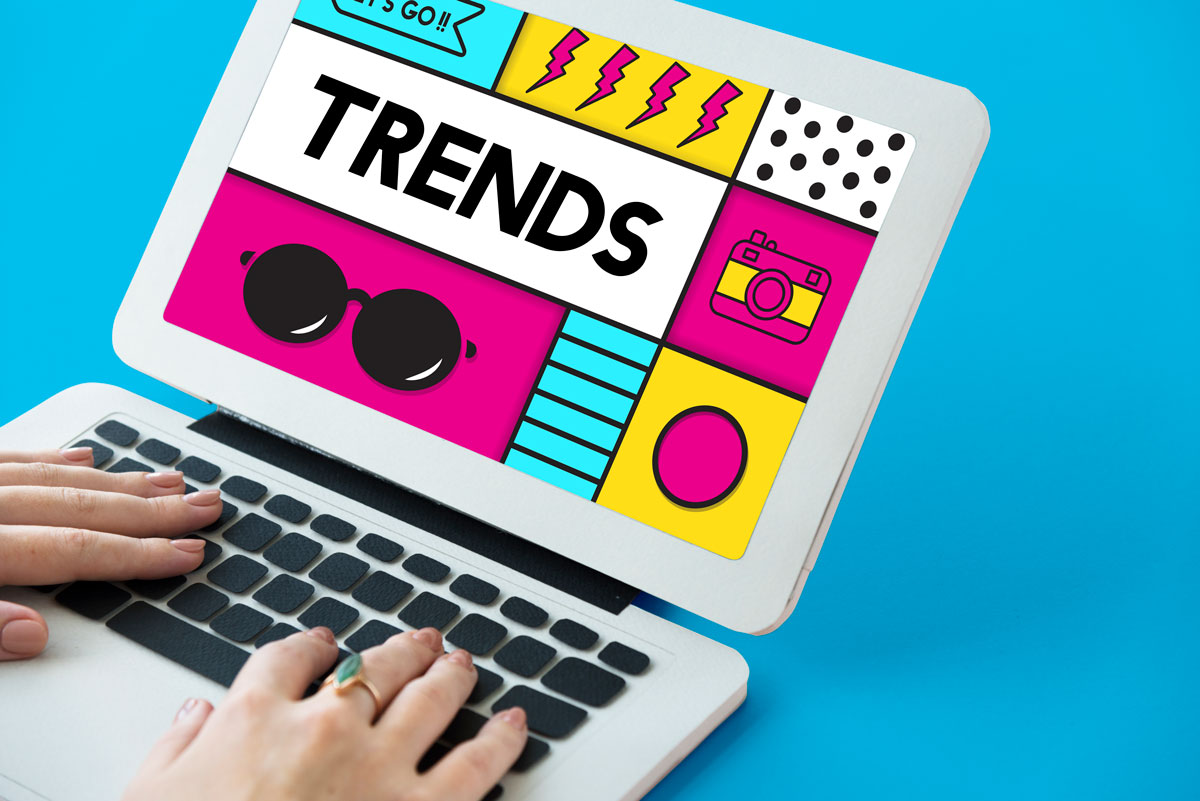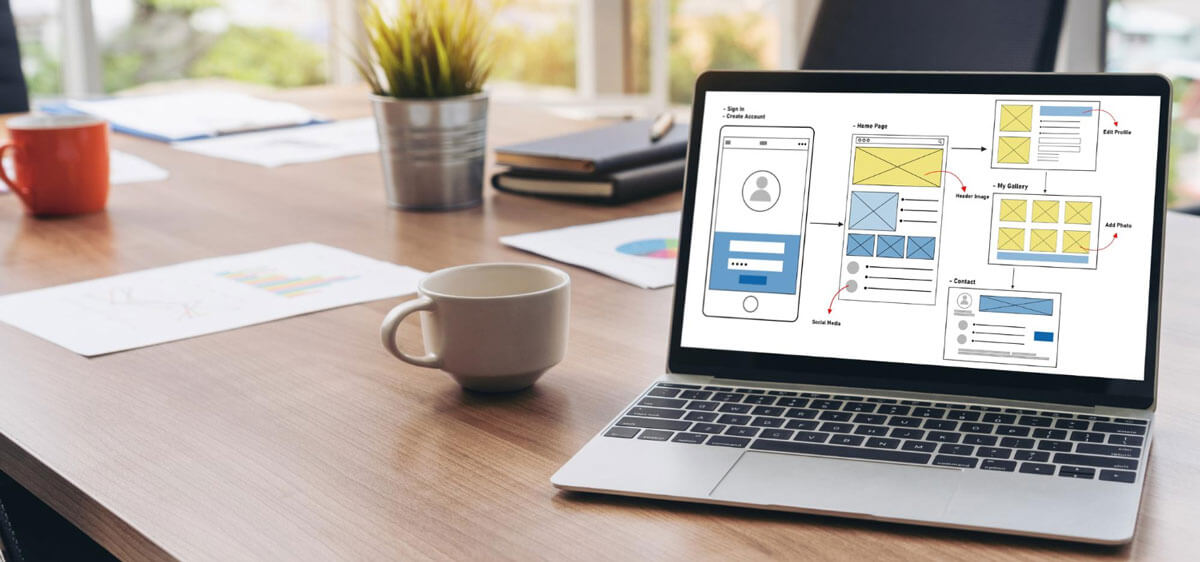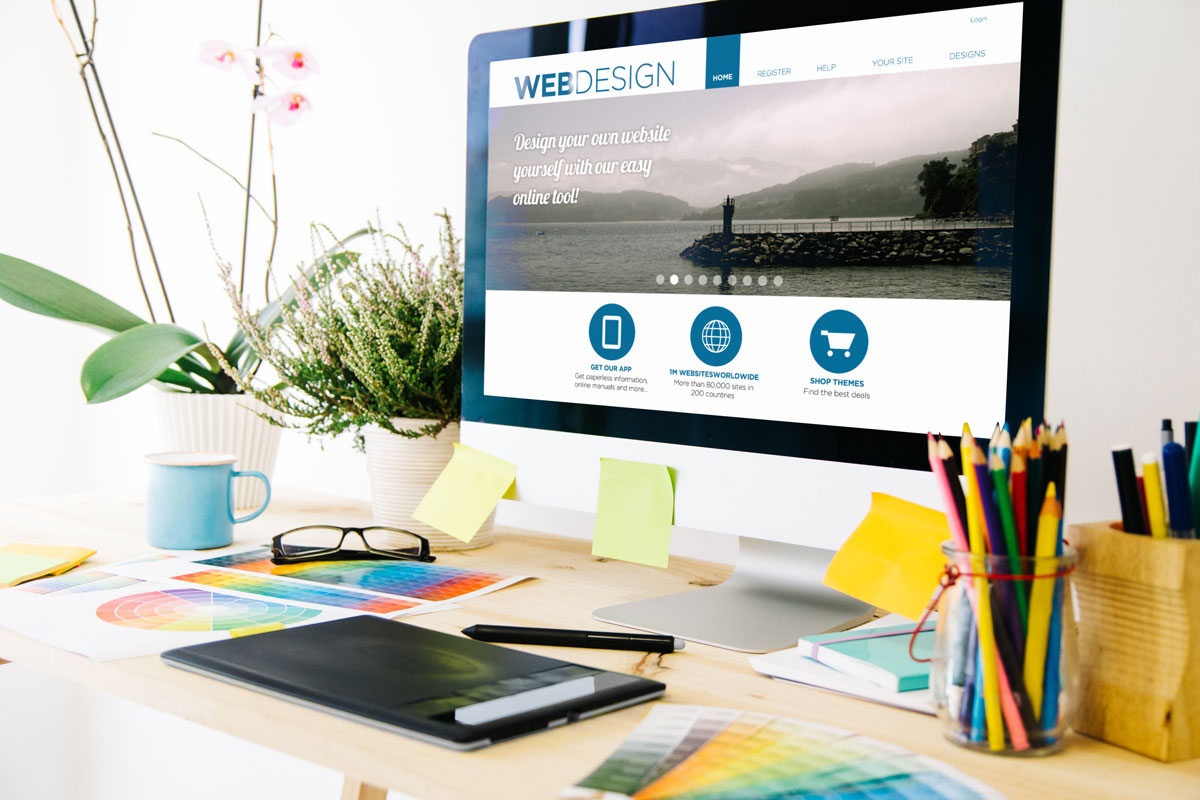Do you want to keep your website current and up-to-date? If so, it's time to brush up on the latest web design trends! With constant technological advances and ever-changing consumer behaviors, it can be difficult for businesses to stay ahead. However, with a complete understanding of the top design trends that are taking shape this year, you can put your efforts to work. From sleek minimalism to vibrant color palettes to smooth animations – get ready for an overview of some of today's hottest design trends!
Historical Overview of Web Design Aesthetics
There has been a noticeable transition in web design from static sites to interactive experiences. Designers adopted interactivity to engage people more deeply as internet speeds increased. Animations were first introduced with JavaScript and CSS3, improving user experiences right away.
This change has transformed online engagement by allowing users to navigate, explore, and interact with material. Interactivity has taken center stage in contemporary online design, from clickable buttons to parallax scrolling, promoting user involvement.
Influence of User Experience (UX) on Design Trends
The rise of user experience (UX) has recently shaped contemporary design trends. User-centric design prioritizes users' needs, preferences, and emotions, influencing everything from layout and typography to color schemes and navigation. Elements such as responsive design, micro-interactions, and personalized design provide enjoyable journeys for users. The websites that users create are not only intuitive, accessible, and capable of evoking positive emotions but also helpful in improving user interactions.
Current Web Design Trends
Minimalism and Clean Layouts
Image source: Freepik
Minimalism has taken the web design world by storm, reflecting simplicity and elegance in layout. As the saying goes, "Less is more," clean layouts devoid of clutter create a visually appealing experience and improve user engagement. With a focus on essential elements, minimalistic design allows users to navigate content effortlessly, promoting a sense of calm and clarity. Using negative space adds to the aesthetics and directs attention to key information, making it a favored trend for enhancing user experience.
Dark Mode and Color Schemes
Image source: Freepik
Dark mode is a sophisticated design choice that serves not only aesthetic preferences but also functional purposes. Dark color schemes reduce eye strain in low-light environments and prolong battery life on devices with OLED screens. The psychological impact of dark backgrounds is also associated with elegance and modernity. By implementing this mode, designers create an interesting transition between light and dark interfaces, allowing users to enjoy content comfortably in any setting.
Bold Typography and Creative Fonts
Image source: Freepik
Typography has gone from a functional element to a design statement. Bold typography and creative fonts inject personality into websites, conveying brand identity and setting the tone for content. The right fonts evoke emotions, create a visual hierarchy, and establish a unique brand voice. Pairing bold typography with compelling visuals forms a powerful visual narrative that captures user attention and encourages engagement.
Asymmetrical Layouts and Broken Grids
Image source: Freepik
Asymmetry introduces a dynamic visual rhythm, drawing users' eyes to unexpected places and growing intrigue. Designers balance asymmetry with harmony, ensuring the layout remains visually pleasing and functional. The strategic use of broken grids adds an element of surprise, encouraging users to explore diverse content arrangements.
Microinteractions and Animation
Image source: Freepik
Microinteractions and subtle animations are the digital heroes of user engagement. These tiny interactions, such as buttons changing color upon hovering or icons responding to clicks, add a layer of interactivity that delights users and creates a sense of responsiveness. Thoughtful animation guides users through the interface, improving usability and creating memorable experiences. Using micro-interactions strategically contributes to a user-centric design that prioritizes intuitive interactions.
3D Elements and Immersive Experiences
Image source: Freepik
Web design embraces the third dimension, incorporating 3D elements that transcend flat visuals. These elements introduce depth, perspective, and a tactile quality that captivates users. 3D graphics create immersive experiences, allowing users to explore products, spaces, or stories in interactive ways. As technology advances, the integration of augmented reality (AR) and virtual reality (VR) further blurs the lines between the digital and physical worlds, enabling unparalleled levels of engagement.
Voice User Interface (VUI) Integration
Image source: Freepik
Voice user interface (VUI) integration represents a futuristic leap in web design, enabling users to interact with websites using natural language. The rise of voice assistants has sparked the need for websites to adapt to voice commands and queries. Designing for VUI involves reimagining user journeys, understanding spoken language nuances, and optimizing content for auditory consumption. As VUI gains traction, websites embrace this trend to offer seamless, hands-free user experiences.
Mobile-First and Responsive Design
Rise of Mobile Browsing and Design Implications
Web design has fundamentally changed due to the explosive rise of mobile surfing. Design considerations are increasingly important as smartphones and tablets replace desktop computers as the dominant internet access devices. Regardless of the device, websites must adjust to different screen sizes and orientations while putting the user experience first. The importance of design features that load fast, continue to operate, and retain their aesthetic attractiveness even on small displays is highlighted by this trend.
Responsive Web Design as a Standard
As a common practice, responsive web design ensures that websites automatically change to meet various screen sizes and resolutions. This strategy eliminates the need for distinct mobile and desktop versions by creating a single website layout that smoothly adjusts to the user's device. Responsive design ensures that information is accessible and appealing across various platforms via adaptable grids and media queries.
Mobile-First Design Strategy
In the pursuit of optimal user experience, the mobile-first design strategy has gained prominence. This approach involves creating the mobile version of a website before expanding to larger screens. By prioritizing the constraints of mobile devices, designers are forced to focus on core content and functionalities. This strategy provides a seamless mobile experience and encourages efficient use of screen space on larger devices. Mobile-first design enhances load times, reduces unnecessary clutter, and aligns with Google's mobile-first indexing, boosting search engine rankings.
Accessibility and Inclusivity
Importance of Web Accessibility
Web accessibility is a fundamental aspect of modern web design, ensuring that websites are usable by individuals of all abilities. This practice eliminates barriers for people with disabilities, granting them equal access to online information, services, and experiences. By prioritizing web accessibility, designers create an inclusive digital environment that benefits everyone, including those with visual, auditory, cognitive, or motor impairments.
Inclusive Design Practices
Inclusive design goes beyond mere compliance – it strives to create interfaces that cater to diverse needs and preferences. Incorporating inclusive design practices involves:
- Considerations such as providing alternative text for images.
- Ensuring color contrast for legibility.
- Offering keyboard navigation options.
Implementing resizable fonts, text-to-speech functionalities, and user-friendly forms is vital to making websites truly accessible and user-friendly for all.
Adhering to Web Content Accessibility Guidelines (WCAG)
The Web Content Accessibility Guidelines (WCAG) are the gold standard for web accessibility. These guidelines provide a comprehensive framework that outlines best practices for designing and developing inclusive websites. Sticking to WCAG principles involves addressing aspects like perceivability, operability, understandability, and robustness of web content. By adhering to WCAG, designers ensure that their websites are compliant and accommodating to a wide range of users, irrespective of their abilities.
Sustainability in Web Design
Eco-Friendly Design Practices
In an era of heightened environmental awareness, web designers embrace eco-friendly practices to reduce their digital footprint. This involves:
- optimizing images and media files to minimize data usage
- adopting efficient coding practices
- utilizing clean and lightweight design elements
By incorporating these eco-conscious choices, designers contribute to a more sustainable online ecosystem, ensuring that the digital realm aligns with environmental values.
Minimizing Carbon Footprint and Page Load Speed
Sustainability extends to the efficiency of the websites themselves. A focus on minimizing carbon footprint and page load speed is environmentally responsible and enhances user experience. Streamlined websites consume fewer resources and load faster, reducing energy consumption and improving user engagement. Designers can create websites that prioritize both speed and sustainability by employing techniques such as lazy loading, efficient coding, and content delivery networks (CDNs).
Sustainable Hosting and Energy Efficiency
Choosing sustainable hosting providers and data centers is another crucial aspect of environmentally conscious web design. Hosting services that use renewable energy sources or employ energy-efficient technologies contribute to reducing the overall carbon footprint of websites. Designers can opt for green hosting solutions and encourage their clients to do the same, ensuring that the digital infrastructure operates harmoniously with the environment.
Personalization and Data Privacy
Customized User Experiences
The era of personalization has transformed web design, enabling tailored user experiences that resonate with individual preferences. By analyzing user behavior, designers can create interfaces that adapt content, recommendations, and interactions to match user interests. Customized experiences enhance user engagement, foster brand loyalty, and create a sense of connection. This trend elevates user satisfaction, from personalized product recommendations to content suggestions.
Balancing Personalization with Privacy Concerns
While personalization enriches user experiences, it must be carefully balanced with data privacy concerns. Collecting user data for customization purposes necessitates responsible data handling and transparency. Designers play a key role in educating users about the data collected and how it's used. By implementing strong security measures, adhering to privacy regulations, and obtaining user consent, designers can ensure that personalization occurs within a framework of trust and respect for users' privacy.
Cookie Consent and Data Handling Practices
Cookie consent and data handling practices have become integral to modern web design. Designers incorporate clear and accessible cookie consent mechanisms that inform users about data collection. Additionally, optimizing data handling practices by anonymizing data, limiting data retention periods, and providing opt-out options empowers users to have more control over their personal information. By adhering to data protection regulations and industry standards, designers ensure user data is treated responsibly.
Impact of Web Design Trends on Business
Brand Identity and User Engagement
Web design trends significantly impact a business's brand identity and user engagement. A well-designed website reflects the essence of a brand, conveying its values, personality, and offerings to visitors. Incorporating current design trends, such as bold typography or immersive visuals, creates a memorable brand experience that resonates with users. Engaging design elements foster longer user sessions, increased page views, and a stronger connection between users and the brand.
SEO and Mobile Ranking Considerations
Web design trends directly correlate with a business's search engine optimization (SEO) efforts and mobile ranking. Responsive design, mobile-friendliness, and fast page load speeds are crucial for search engine algorithms. As search engines prioritize mobile-first indexing, websites that align with mobile design trends enjoy higher rankings. By incorporating SEO-friendly design practices, businesses can enhance their online visibility and attract organic traffic.
Conversion Rate Optimization (CRO) Strategies
Web design trends are pivotal in Conversion Rate Optimization (CRO) strategies. Design elements that guide users' attention, simplify navigation and emphasize calls-to-action contribute to higher conversion rates. Leveraging micro-interactions, persuasive visuals, and intuitive layouts can nudge users toward desired actions, such as signing up for newsletters or purchasing. Effective CRO-driven design increases the likelihood of turning visitors into customers, ultimately boosting a business's bottom line.
Navigating Design Trends Wisely
Focusing on Timeless Design Principles
Among the ever-evolving landscape of design trends, grounding your choices in timeless design principles is essential. While trends come and go, fundamental principles such as clarity, readability, and visual hierarchy remain constant. Incorporating these principles ensures that your design remains accessible and user-friendly, regardless of fleeting trends. Combining innovation with established principles allows you to create designs that stand the test of time.
Adapting Trends to Suit Brand Identity
While embracing design trends can infuse freshness into your brand, it's important to tailor them to your brand's identity. A design trend that aligns seamlessly with one brand may not necessarily resonate with another. Consider how the trend fits into your brand's narrative, values, and target audience. By adapting trends to harmonize with your brand's essence, you create a cohesive, authentic design that resonates with your audience.
Balancing Aesthetics with Functionality
Striking the delicate balance between aesthetics and functionality is at the core of effective design. While aesthetics captivate, functionality ensures usability. It's tempting to get swept up in the allure of trends, but they should enhance rather than hinder user experience. Prioritize seamless navigation, quick loading times, and user-friendly interfaces. By maintaining the equilibrium between aesthetics and functionality, you create designs that look great and deliver a smooth and satisfying user journey.
AI and Personalized User Experiences
Artificial intelligence (AI) integration has shown in a new era of personalized user experiences. Its intricate algorithms analyze user behavior, preferences, and historical data to curate tailor-made content recommendations. This dynamic approach to content delivery enhances engagement by presenting users with relevant information and products, effectively anticipating their needs.
Furthermore, including AI-driven elements like chatbots and virtual assistants has transformed user interactions. These intelligent entities provide real-time responses, streamline navigation, and offer immediate solutions, acting as digital guides throughout the user's journey.
Notable examples include e-commerce platforms employing AI to suggest products based on browsing habits and content platforms customizing article suggestions to align with a reader's interests. These instances spotlight AI's capacity to bridge the gap between user expectations and web design, resulting in a more engaging and meaningful online experience.
Immersive Visuals: 3D, VR, and AR
The world of web design is embracing a new dimension by integrating 3D visuals, virtual reality (VR), and augmented reality (AR). These technologies are revolutionizing user experiences by transporting visitors into captivating virtual realms.
3D visuals infuse depth and realism, transforming static elements into interactive objects that users can manipulate. Virtual reality, on the other hand, engages users in entirely different environments, enabling them to explore digital landscapes as if physically present. Augmented reality blends the virtual and real worlds, enhancing physical surroundings with digital overlays. These technologies have an unprecedented potential to engage users, inviting them to explore and interact with content in novel ways.
By capitalizing on 3D, VR, and AR, web designers can craft narratives that unfold seamlessly, allowing users to participate and engage actively. Imagine touring a virtual art gallery, exploring products in a lifelike 3D space, or virtually previewing furniture within your living room before purchase.
Many online websites use these technologies to deliver remarkable experiences. For instance, an online museum employs VR to transport visitors into historical eras, providing an interactive perspective on art and culture. An e-commerce site utilizes AR to enable customers to visualize how furniture fits into their homes. A travel company offers 360-degree VR tours of exotic destinations, enticing potential travelers with a taste of their next adventure.
Conclusion
With new trends joining the digital era, designers need to update and evolve their techniques. And it all starts with two important steps: understanding what consumers are looking for and including new technologies in their methods. Put simply, staying ahead of web design trends is not only beneficial but also necessary for businesses to continue giving customers great experiences. So, if this is your goal, don't forget to take action today and make sure your site is designed with modern trends in mind!
FAQs
What are the latest web design trends for this year?
The latest web design trends for this year encompass a range of elements, including minimalistic and clean layouts, immersive visuals like 3D, VR, and AR integration, personalized user experiences driven by AI, dark mode implementation, bold typography choices, and a focus on sustainability and ethical design practices.
Why are minimalistic layouts trending in web design?
Minimalistic layouts have gained traction due to their ability to convey information clearly and concisely. By removing clutter and focusing on essential elements, minimalistic designs improve user experience, load times, and navigation.
How are immersive visuals like 3D, VR, and AR impacting web design?
Immersive visuals like 3D, VR, and AR are revolutionizing web design by creating engaging and interactive experiences. 3D visuals add depth and interactivity to static elements, while VR transports users to virtual environments, and AR enhances reality by overlaying digital content.




